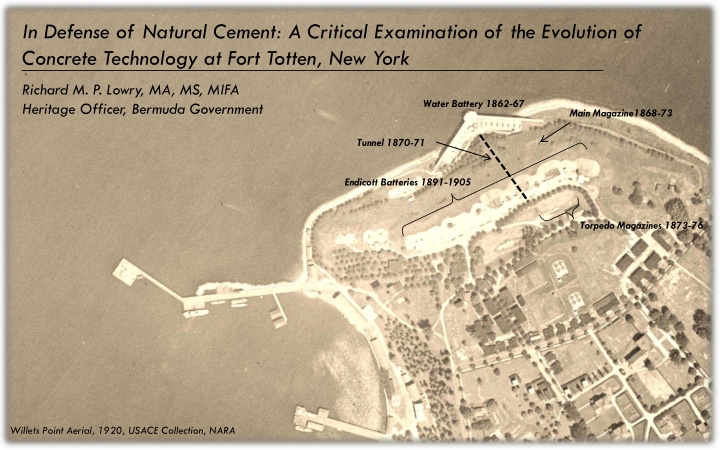



In Defense of Natural Cement: A Critical Examination of the Evolution of Concrete Technology at Fort Totten, New York Richard M. P. Lowry, MA, MS, MIFA Water Battery 1862-67 Heritage Officer , Bermuda Government Main Magazine1868-73 Tunnel 1870-71 Endicott Batteries 1891-1905 Torpedo Magazines 1873-76 Willets Point Aerial, 1920, USACE Collection, NARA
US Army Corps of Engineers at Willets Point Willets Point/Fort Totten HQ of the Corps of Engineers (1866- 1901) Engineering Depot USACE electromagnet, Fort Totten, 1892 (Fort Totten Museum (1866-1901) Collection) Engineering School of Application (1867- 1901) Torpedo School (1869- 1908) Essayons Club (1868-1882) Maj. Gen. Henry Abbot, (1831-1927)
Changes in Fortification Construction: Masonry to Concrete No. 3 Plan of Fort at Willet's Pt., L.l. June 25, 1863, Plan, Elevation and Sections for Battery Mahan, Fort at Willets Point, N.Y. View of Excavations Fort Totten, built 1898-1900 (NARA) Sections and Plan of the Main Magazine (NARA) and Embankments’, ca. 1863 (NARA ) Construction of the batteries and magazines at Fort Totten, ca. Endicott Battery Graham 1 Endicott Battery Sumner1 Endicott Battery Graham 1 1890s, showing wooden formwork (BHS Collection) (1892-1896) with later (1891-1897) with later (1892-1896) extensions (1903-1905) extensions (1903-1905)
Fort Totten Fortifications: Structures examined Water Battery (1863-1867) Tunnel (1870-1871) Torpedo Magazines (1873-76) Masonry with coarse infill NC concrete NC concrete NC concrete Battery Sumner (1891-97) Battery Graham (1892-98) Battery Mahan (1898-1905) NC concrete with later PC concrete additions NC concrete with later PC concrete additions PC concrete
Concrete Development at Fort Totten: Changes in mix design Exposed NC concrete north entrance of the Coarse infill NC concrete showing plenty of Exposed NC concrete showing large unbroken Tunnel (1870-1871) strained quartz river gravel used at the Water gravel aggregate in the Tunnel (1870-1871) Battery (1862-67) Coarse NC concrete foundations of PC concrete lifts with diabase aggregate Battery Partially completed doorway cut through the Battery Graham I (1892-1897) Mahan I (1898-1900) NC concrete sidewall Torpedo Magazine III (1873-1876)
Natural Cement Concrete Conditions: Torpedo Magazines Vertical crack in Torpedo Magazine IV (1873-1876) Interior of Torpedo Magazine V (1873-1876) Crack between Torpedo Magazines I and II (1873-1876)
Natural Cement Concrete Conditions: Main Magazine, Battery Sumner and Battery Graham Interior of the Main Magazine (1868-1873) Spalling and cracking along emplacements at Battery Graham I (1892-1897) Cracking along emplacements at Battery Sumner I (1891-1897)
Portland Concrete Conditions: Battery Mahan Expansion cracking along traverse extension of Battery Mahan I (1902-1905) Cracking along traverse at Battery Mahan I Significant failure along concrete lifts at the traverse of Battery Mahan 1 (1898-1900) (1898-1900)
Polarized Light Microscopy: Natural Cement and Portland Cement Identification NC grain, from sample G2U-2A Belite, PC from sample G2U-2A Alite, PC from sample M1L-1B Battery Graham II (1892-1897) Battery Mahan I (1898-1900) Battery Graham II (1892-1897)
Polarized Light Microscopy: Lift Boundaries Ettringite Ettringite Precipitated calcite crystals along the lift boundary of Depleted calcium hydroxide along the lift Lift boundary from NC sample S1U-C2 Battery NC sample S1UC.2 Battery Sumner I (1881-97), boundary of PC sample M1U.C (1898-1900) Sumner I (1891-97) showing carbonation evidence of freeze/thaw cycling
Polarized Light Microscopy: Alkali Silica Reaction Possible ASR, from NC sample S2U-1B Battery Sumner II (1896-98) below Classic ASR seen at the High Line, Manhattan, NY Image courtesy of Andre Georges, Robert Silman Associates
Interesting Findings: Surface Coatings slag 3” 2” Ground slag inclusions, from NC sample G1L-1A PC pargetting on NC sample G2U-2A Limewash coating on NC concrete, from NC sample Battery Graham (1892/98) below TM4.3A2 Torpedo Magazine IV (1873/4) below Battery Graham I Foundations (1892-97) below
Interesting Findings: Entrained Air Entrained air, from PC sample M2L-1A PC sample M2L-1A taken from concrete window lintel at Battery Mahan 2 Extension (1903-1905) Battery Mahan 2 Extension (1903-1905)
Conclusions No evidence of an inherent problem with the natural cement concrete fortifications at Fort Totten Appropriateness of design, subsidence, and lack of expansion joints Switch to portland cement: greater workability, better suited to reinforced concrete in ea. 20 th C Other factors to consider: economics and domestic production Clear development of concrete mix design and evidence of experimentation FURTHER RESEARCH Archival research on cement brands used Historic graffiti in Tunnel Analyze concrete in Main Magazine, Tunnel, Barbette Magazines
Thank You Special thanks to Prof. Norman Weiss and Prof. Joan Berkowitz, Columbia University John Walsh, Highbridge Materials Testing John Krawchuck, NYC Parks and Recreation Ken Uracius & Chris Perry, Stone & Lime Inc. rmlowry@gov.bm http://academiccommons.columbia.edu/
Recommend
More recommend